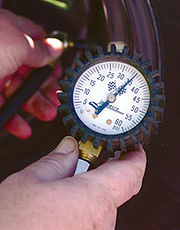
Tire-pressure gauge
Encyclopedia

Pressure measurement
Many techniques have been developed for the measurement of pressure and vacuum. Instruments used to measure pressure are called pressure gauges or vacuum gauges....
used to measure the pressure
Pressure
Pressure is the force per unit area applied in a direction perpendicular to the surface of an object. Gauge pressure is the pressure relative to the local atmospheric or ambient pressure.- Definition :...
of tire
Tire
A tire or tyre is a ring-shaped covering that fits around a wheel rim to protect it and enable better vehicle performance by providing a flexible cushion that absorbs shock while keeping the wheel in close contact with the ground...
s on a vehicle.
conditions can introduce a 13 to 15 percent variability in pressure due to temperature (0 °C to 40 °C), and additional changes can result due to altitude. Most car owner manuals do not state rated pressure as a function of temperature or altitude and leave it to the user to make appropriate measurements.
Since tires are rated for specific loads at certain pressure, it is important to keep the pressure of the tire at the optimal amount. Tires are rated for their optimal pressure when cold, meaning before the tire has been driven on for the day and allowed to heat up, which ultimately changes the internal pressure of the tire due to the expansion of gases. The accuracy of a typical mechanical gauge as shown is ±3 psi (20.7 kPa). Higher accuracy gauges with ±1 psi (6.9 kPa) accuracy can also be obtained.
Built-in tire pressure sensors
Many modern cars now come with built in tire pressure sensorPressure sensor
A pressure sensor measures pressure, typically of gases or liquids. Pressure is an expression of the force required to stop a fluid from expanding, and is usually stated in terms of force per unit area. A pressure sensor usually acts as a transducer; it generates a signal as a function of the...
s that allow all four tire pressures to be read simultaneously from inside the car. In 2005, most on-board TPMS used indirect pressure monitoring. The anti-lock brake sensors detect one tire rotating faster than the rest and indicate a low tire pressure to the driver. The problem with this method was that if tires all lost the same pressure then none would show up against the others to indicate a problem.
Regulations on tire pressure
Since September 2007 all new automobiles below 10000 lb (4,535.9 kg) in weight sold in the United States are required to incorporate a Tire Pressure Monitoring System (TPMS), which is capable of monitoring all four tires and simultaneously reporting under-inflation of 25 percent of cold placard pressures in any combination of all four tires. TPMS known as Direct TPMSDirect TPMS
Direct TPMS, or direct tire pressure monitoring systems refers to the use of a pressure sensor directly mounted on the wheels or tires of a vehicle. The pressure inside the tire is measured using a pressure transducer with the pressure information being subsequently sent to the vehicle to warn the...
are capable of TREAD Act legislation requiring simultaneous pressure measurement for each tire pressure.
Early TPMS sensors required batteries but the latest TPMS technology eliminates all sensor batteries.

